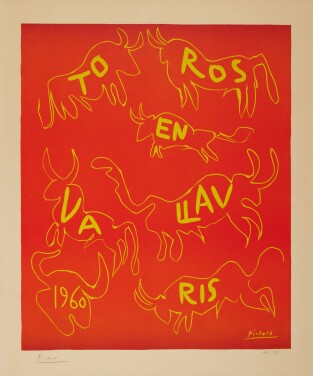S otheby’s is pleased to present Pablo Picasso including Important Ceramics from a Japanese Family Collection, a dedicated sale featuring over 70 lots of the artist’s editioned works. The sale is led by lots 1-41, important ceramics from a Japanese Family Collection, including Arène (A. R. 406), Pichet à glace (A. R. 143) and Gros oiseau Picasso (A. R. 185), as well as Quatre personnages - Vase à pans coupé, a unique ceramic in Sotheby’s Modern Day Auction.
Spanning the artist’s career and with estimates ranging from $1,000 to $100,000, the diverse selection of works in this sale appeals to new and experienced collectors alike. Bidding will open on 14 November and lots will begin to close on 22 November.
Highlights from a Japanese Family Collection
Additional Highlights
In 1946 while vacationing with his lover Françoise Gilot at Golfe-Juan in the South of France, Picasso met Georges and Suzanne Ramié, the owners of the Madoura pottery studio in the nearby town of Vallauris. The Ramiés welcomed Picasso into their workshop where the artist created three ceramic objects, a head of a faun and two bulls. While Picasso had experimented with clay almost 40 years earlier, this encounter at Madoura so captivated his interest that the artist returned a year later, sketches in hand and his head brimming with ideas. He began working at Madoura daily, completing over 1,000 unique pieces between 1947 and 1948. This was the start of a friendship and creative partnership with the Ramiés that would last until Picasso’s death.
Acknowledging the inherently serial nature of pottery production, Picasso and the Ramiés decided to make multiples of his ceramics that would be sold at Madoura. By this time Picasso was a world-renowned artist, and being well aware of his fame, he wanted to make his work more accessible. “I would like them to be found in every market, so that, in a village in Brittany or elsewhere, one might see a woman going to the fountain to fetch water with one of my jars.” And so, between 1947 and 1971, Picasso designed 633 different ceramic works that were to be made in editions of 25 to 500.
Painting in the Round
One of the many reasons Picasso was drawn to ceramics was that they allowed him to paint in the round, something he could never achieve on canvas. Using volume as an integral element, Picasso decorated three-dimensional works with his distinctive style, creating works that demand to be viewed from multiple angles.




































